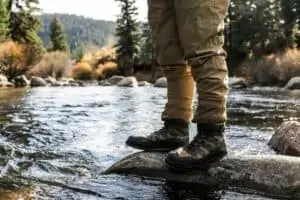Trout Fishing Rigs Setup: Beginner’s Guide
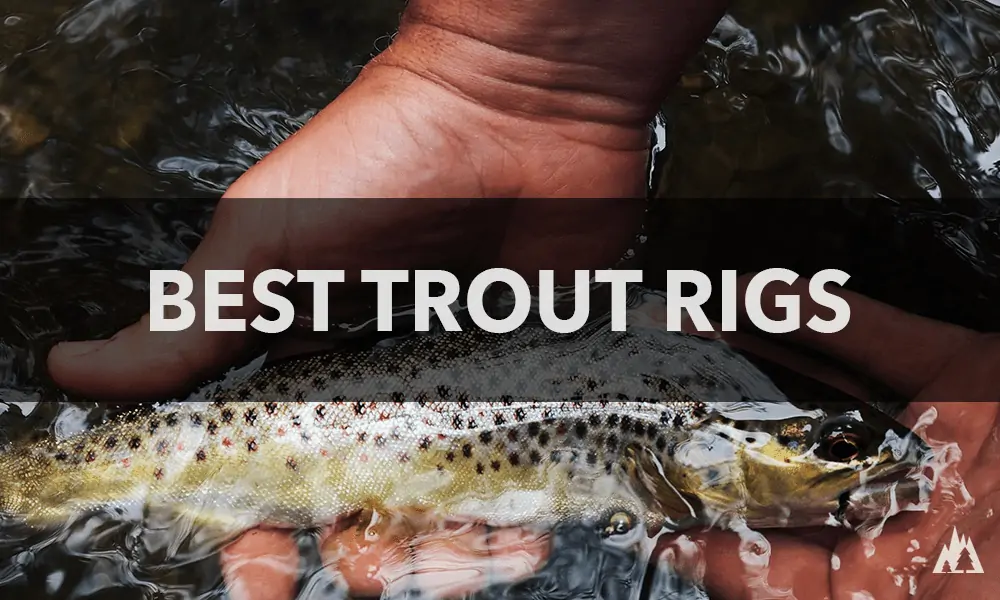
Anglers love fishing for trout in North America. They are found in abundance and across many habitats. While trout fishing appears complex on the surface, it is quite easy to enjoy with the right mix of skill, knowledge, and patience.
The most important thing for trout fishing is setting up the right fishing rigs.
In this article, let’s walk through the different forms of trout fishing rigs and select the right choice for you.
Setting Up A Trout Fishing Rig
You can choose from a variety of trout fishing rigs depending on whether you are going to use a sinking bait, bobber, or lure, to fish.
However, before you dive into the world of each trout rig, let’s review the basics of setting up one.
- Tie. Begin by tying off the fishing hook using a good knot to the tip of the line. You can either use one of these knots—Improved Clinch or Palomar. Both provide strength and quality performance when trout fishing.
- Loop. After you have knotted the line, loop it through the other side of the hook hole.
- Tighten. Once you have looped the line through the hole, tighten it and make sure it is properly anchored through the topmost and bottom hooks. You will also need to add the split shot, bobber, and bait to your trout rig setup.
Best Trout Fishing Rigs Setup
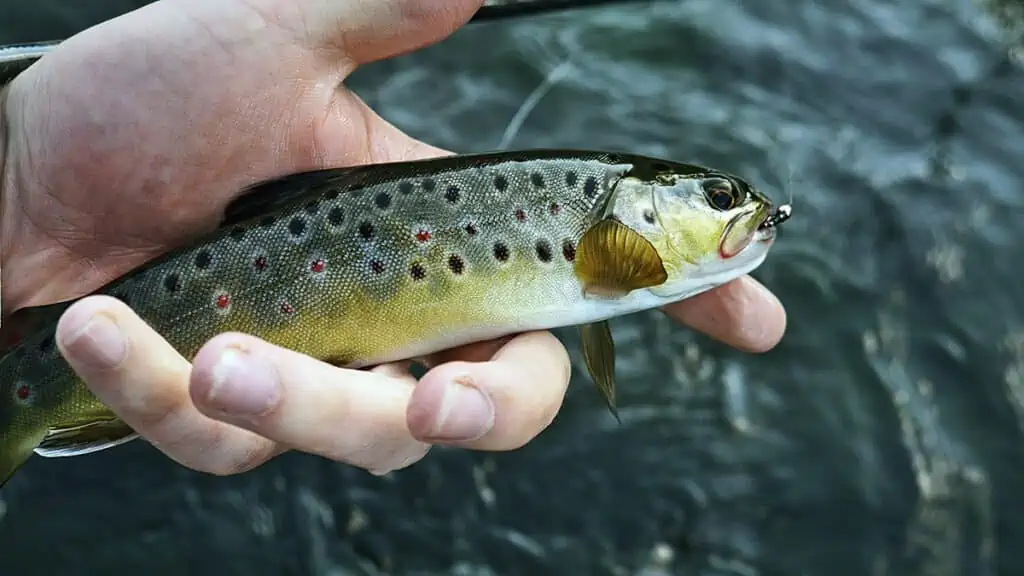
Whether you are a beginner or a pro at trout fishing, the below trout fishing rig setups will ensure that the fish bite and your fishing trip is a success. You need the right trout rod, reel, and fishing line to make this possible.
There are three basic trout fishing rigs. These come in various forms, each suited for different fishing applications. Let’s explore the different forms of setup so you can select the best trout fishing rigs for you.
Bobber or Float Fishing Rigs for Trout
If you are an angler who prefers visual fishing, you should opt for the bobber fishing rig. A bobber rig is split into two varieties. A slip bobber takes some effort to set up but it is very effective for trout fishing. On the other hand, a fixed or clip-on bobber works well for trout fishing in shallow bodies of water.
Fixed Bobber Trout Rigs
This is the easiest trout rig to set up. This bait fishing rig requires a fixed bobber, a hook, and split shot weights to push down the hook with the bait.
The bobber rig setup involves the following process.
Once you attach the bobber to the fishing line, you have to tie up the tip of the line to the hook. Your casting depth will depend upon the distance between the hook and the bobber. However, if the distance is too great, the line can get tangled up, and you will not be able to cast it effectively.
If you are a novice angler, you can use a round fixed bobber to set up your bobber rig. You can also opt for the pencil bobber. It is a sensitive float with very little resistance to offer when the fish latch on.
The bobber rig is a great rig for trout fishing in shallow waters. It is easy to start off as a beginner targeting stocked trout.
Get a bait on your hook and cast the rig into the water. Once you spot the bobber get pulled under, hook the fish immediately before it has a chance to expel the hook. You can try powerbait with your float fishing rig to lure the trout.
Slip Bobber Trout Rigs
This particular slip bobber rig setup works well in moving water like creeks and rivers. The use of a slip bobber instead of a fixed bobber makes a difference in usage.
It is widely used since it makes your rig compact and allows you to fish in varying ranges of depth. They are mostly used at maximum depths of up to 30 feet, but you can cast in them deeper waters.
First, you will need to attach the slip bobber to your fishing line. Then loop the line around your bobber and tie it off at the hook. Add a split shot between the hook and the slip bobber to weigh down the bait at the desired depth for the trout. The attachment also prevents the bobber from slumping down to the hook.
A slip bobber rig can be used to fish at any depth. This rig for trout is most commonly used to fish for trout in rivers and streams. It is favorable since you can quickly adjust the depth on the fly as you move across the water body.
Once you have pinpointed the depth you want to target, move the slip bobber along the line to that depth. It works best with bait. Simply attach one to your hook and cast your rig at the selected depth. Sit back and wait for a trout to bite!
Bottom or Sinking Fishing Rigs for Trout
The bottom fishing rig for trout is relied upon by many anglers because it is capable of catching trout of any size. It is the best option to lure trout that move and gather at the bottom of the water.
One of the interesting things about bottom fishing is that there are several fishing styles to choose from. You can experiment with what suits you best.
Slip Sinker Trout Rigs
The slip sinker rig for trout tops the list because it is the easiest and most widely used bottom fishing rig. The sinking bait trout rig is popular among novice anglers.
For this setup, you will require a slip sinker, swivel, hook, and bait. The rig is easy to construct.
Firstly, you need to set up a slip sinker by threading its eye through the end of the fishing line. Tie off the end with a swivel to prevent the sinker from sliding off. Tie 18 to 24 inches of fishing line at the end of the swivel, and then add on a hook with a trout bait. Your size and type of hook should depend upon your choice of bait.
Additionally, your leader should be lighter than your main fishing line. This is done so that even if you lose the line, it is just the end and not your entire rig.
The slip sinker rig is a common choice in waters of depth over 10 feet. You will need to attach a floating bait, such as powerbait, to your sinking bait rig if you want the trout to notice it. This is a rather passive trout fishing rig. You can simply cast out the rig at the desired spot and wait for trout to walk into the trap.
Carolina Trout Rigs
The Carolina rig for trouts is quite similar to the above slip sinker setup. The best thing about this rig is that you can fish both actively and passively with it. It mostly makes use of artificial lures, unlike slip slinker’s bait fishing rig setup.
You will require a simple egg sinker, a bead, a swivel, a leader, and a hook. Attach your sliding sinker to your main line, followed by the plastic bead. Then tie off this line to a swivel. Get around 12 to 24 inches of leader line and tie it off at the other end of the swivel.
The bead is an important component if you are planning to fish actively. It prevents the sinker from hitting the swivel and damaging it in the process. The addition of the plastic bead will strengthen the rig and reduce its chances of breaking.
When you attach the bait, ensure that it is not dragging at the bottom, as the trout will ignore it. Use a buoyant bait for this sinking bait rig so that it remains suspended over the bottom rather than lying directly on it.
If you are actively using a Carolina fishing rig, it will dredge through more ground. However, its effectiveness is proportional to the skill and technique applied.
When using a floating lure, make sure not to pull up your rig fast. Once you sense a bite, wait a few seconds before you set the hook.
Split Shot Trout Rigs
This is the ‘finesse style’ of the Carolina rig. It swaps out the slip sinker for split shots. The rig is simple, requiring a few split shot weights, a swivel, a leader, and a lure.
Thread your fishing line through one end of the swivel and slip in one or more split shots over the swivel. Thread a leader (one to two feet in length) through the other end of the swivel and tie a hook at the end of it.
Once you attach a floating lure to the hook, you are all set to begin fishing.
A split shot trout rig is a great setup to use if the trout are fussy. This occurs mostly in waters with excessive fishing. The subtle rig will be advantageous when fishing for finicky trout as it will not be easily visible.
However, this rig for trout does have one main disadvantage. As opposed to the Carolina rig, it packs less weight, and therefore, it cannot be cast at further distances. It works well for trout fishing in smaller lakes, creeks, streams, and rivers.
Drop Shot Trout Rigs
Yet another best trout fishing rig for bottom fishing is the drop shot setup. It is a finesse fishing technique meant for clear waters and rough conditions. It is quite effective for catching trout.
It works well for both novice and pro anglers. You can drop the bait in structures such as docks and weed beds.
This setup also uses artificial lures like the previous two setups. To set up this rig, you will require a 1/8 to 1/4 ounce drop shot weight. Opt for the lightest possible weight unless you plan to hit the deep waters.
To get started, use a double uni knot to tie your main fishing line to a 4-foot fluorocarbon leader line. Thread the end of the leader through the eye of the drop shot weight.
Loop the hook through the leader line at a distance of approximately one foot from the drop shot weight. The hook should be at a 90-degree angle and facing upward. Tie the end of your leader line to your main fishing line.
Since it is extremely versatile, it can be used for trout fishing in both deep and shallow water. This rig for trout allows your bait or lure to hang out in the target zone for a lengthier period of time. This considerably improves your chances of getting a bite.
You can use soft plastics, bait such as corn, etc with this versatile rig type.
Lure Fishing Rigs for Trout
There are certain rigs for trout that are only meant for lures. They are the easiest and the best trout fishing rigs. It does not have as many components as the other trout fishing rigs, like the bobber rig and bottom fishing rig.
The lure fishing trout rig can be as simple as just tying a lure to the end of your fishing line. Here are some setups on how to connect a trout fishing lure.
Spinner Rigs
This lure rig is commonly used with spinners. Spinners act as productive trout fishing lures. However, you may use it with any artificial lure that requires some additional weight to hit the bottom.
Thread the main fishing line through the trout lures swivel. Drop at least one split shot weight over the swivel. The total split shot weights required will depend upon the weight and size of your lure. Additionally, you will need at least a two-foot leader line to thread through the other end of the swivel.
The swivel is meant to prevent your main line from getting tangled. However, you can skip this if you have a lure that will not generate a twist.
This versatile trout fishing rig works well in a variety of settings—from small water bodies to deep ones. The spinner fishing rigs are mostly used in moving currents, but you can cast them in lakes too.
You have to do minimal work with a spinner rig setup. Simply cast your rig and slowly begin a steady retrieve.
Bobber and Jig Trout Rigs
This trout rig works great when you are fishing over weed beds. Depending on how deep the water runs, you can choose between a fixed bobber and a slip bobber.
The setup is similar to a bobber rig assembly. However, instead of knotting a baited hook at the end of the main line, you will tie a jig head. You can then attach any lure to the jig head.
The bobber keeps the jig from getting tangled in the weeds if you are over weed beds. Set the exact depth of your bobber to ensure the lure lies over the weeds. You can also use this rig set up for drift fishing.
Once you are over a good trout fishing spot, cast your rig into the water. Once the jig sinks in, you may start the jigging action with a gentle tug on the rod tip. This form of fishing makes the plastic lure appealing to trout, and you will get good bites.
Ned Rigs
Anglers who fish for bass are most familiar with ned rigs. However, it is quite effective in catching trout as well. The contributing factor to its effectiveness is the floating plastic lure.
This is by far the easiest rig to set up. Simply tie the ned rig’s jig head to your fluorocarbon main line. If you are not using a fluorocarbon main line, then you need to introduce at least a two-foot fluorocarbon leader. The fluorocarbon line is given preference because it is far less visible underwater than a braided line.
You can use a ned rig set up in almost all situations except for when there is a lot of bottom vegetation.
It is quite simple to use too. Simply cast it and allow it to sink all the way to the bottom. Once it hits bottom, jig it up gently and repeat the process till a trout snags on.
Trout Fishing
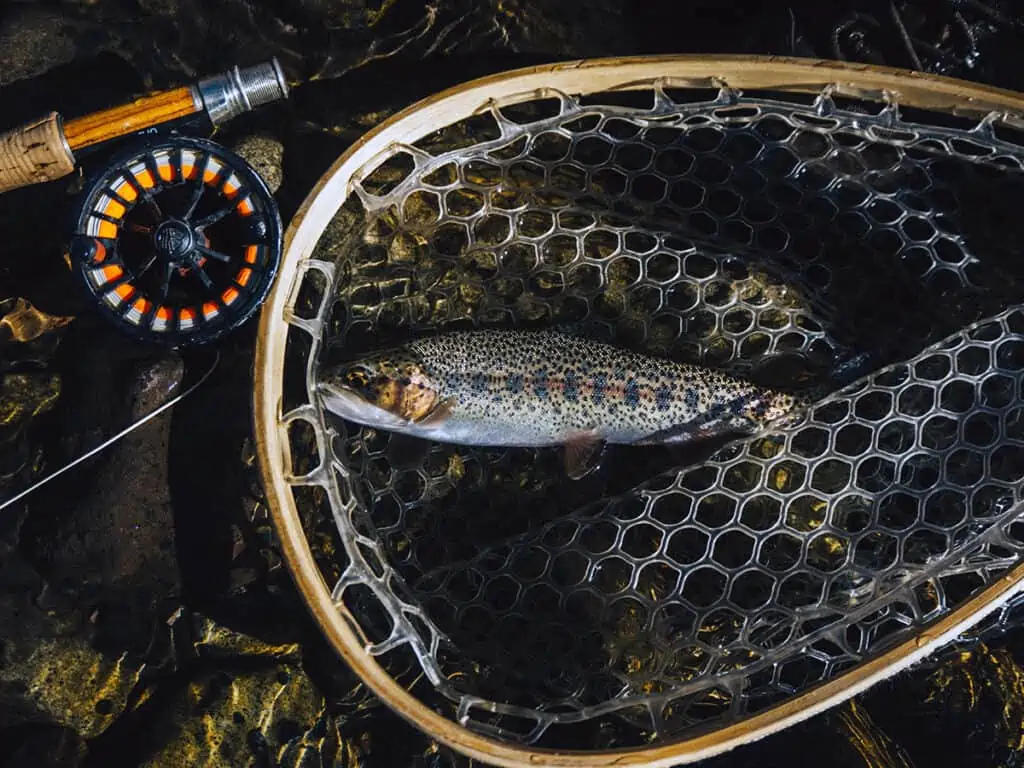
Close relatives to the salmon, trout is a species of freshwater fish that are found in varying habitats and environments.
You will find lake trout exclusively in freshwater lakes and rivers, while others like rainbow trout alternate habitats between the sea and freshwaters. Since they live in such different environments, trout have varying dramatic colors and patterns. These colors offer them a camouflage advantage.
Related Post: How To Catch A Palomino Trout
A trout fishing rig consists of a combination of whatever items you will require to attract and land a good catch.
Here is a quick overview of everything you will need to create the best trout fishing rig.
Fishing Rods and Reels
If you do not already have a decent rod and reel combo for trout fishing, you should purchase one. Any spinning rod between 6’6” and 7’ is effective for trout fishing. This length works for shore or boat fishing.
However, some anglers tend to go for short rods if their fishing grounds are in tiny overgrown streams.
Fishing Line
It is likely that your fishing rod and reel combo came with a fishing line. However, if you find yourself without one, go for at least a 4-pound test line. Most anglers prefer to use the monofilament lines when trout fishing because they are so versatile.
If you are heading out into big rivers for trout fishing, consider an 8-pound test line. The middle ground is a 6-pound test line for baits and lures.
You can also opt for a fluorocarbon fishing line. These lines are less likely to spook the trout since they are mostly invisible.
Hooks
In trout fishing, you should always go for the smaller hooks. Trouts spook easy, especially in clear waters. They also have smaller mouths. So the ideal hook size for trout fishing is 8 to 14. The most common choice is a basic hook, such as a single hook.
Try out the hooks with the bait and see what works best for you.
Bobbers
Since trouts are skittish, you will need a lightweight bobber to lure them. If you use a bigger bobber than required, you will risk the fish fleeing from the resistance.
You can opt for a basic bobber. Just ensure that the bobbers are the right size to stop the hook, bait, and split shot from sinking.
Sinkers
Lightweight sinkers are most commonly used in trout fishing. Use 1/8, 1/16, and 1/64 oz sinkers. The lightest weight will ensure that your bobber does not get dragged down.
Baits and Lures
If you want to catch trout, you will have to select a bait that is close enough to the trout’s diet. The best baits are fish eggs, flies, worms, minnows, and even live baits. Worms are a popular choice among anglers for trout bait.
Summary
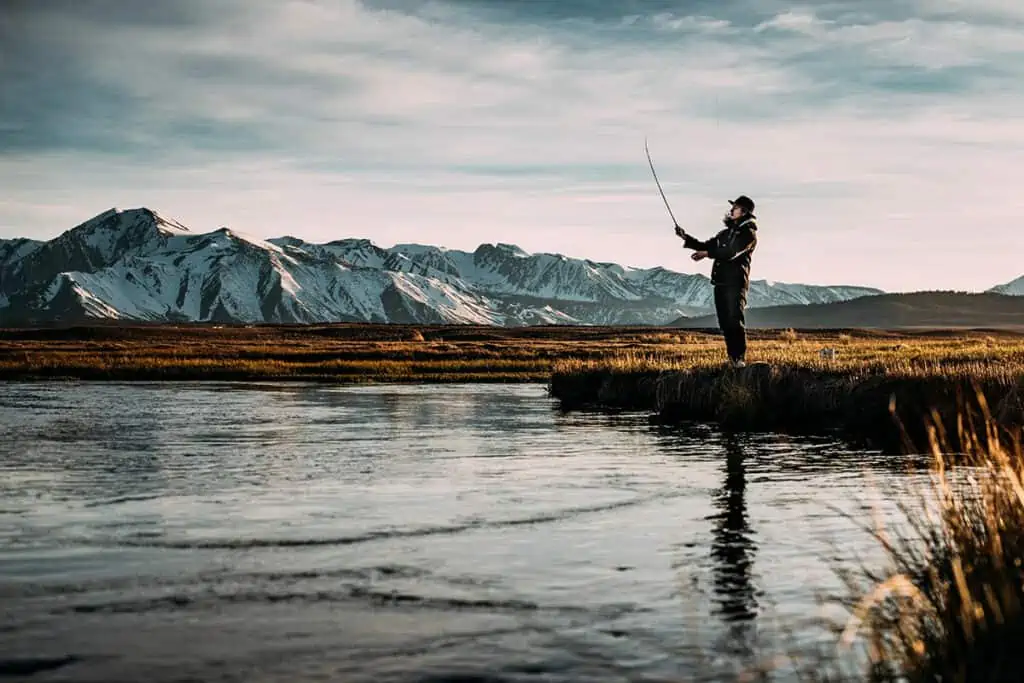
You can fish for trout effectively with the above-mentioned best trout fishing rigs. Trout rigs such as the slip bobber, slip sinker, and spinner allows you to catch trout in any water.
Even if you are a beginner in the trout fishing world, you will do well with most of the rigs for trout. The rigs vary depending upon the various bodies of water and fishing tactics used.
Don’t forget other trout fishing gear such as fishing shoes and sunglasses to help make the day out on the water more comfortable.
Even though most trout are commonly stocked game species, please practice catch and release fishing.
And more importantly, have fun!






